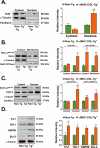Hydrogen sulfide mediates cardioprotection through Nrf2 signaling
- PMID: 19608979
- PMCID: PMC2735849
- DOI: 10.1161/CIRCRESAHA.109.199919
Hydrogen sulfide mediates cardioprotection through Nrf2 signaling
Abstract
Rationale: The recent emergence of hydrogen sulfide (H(2)S) as a potent cardioprotective signaling molecule necessitates the elucidation of its cytoprotective mechanisms.
Objective: The present study evaluated potential mechanisms of H(2)S-mediated cardioprotection using an in vivo model of pharmacological preconditioning.
Methods and results: H(2)S (100 microg/kg) or vehicle was administered to mice via an intravenous injection 24 hours before myocardial ischemia. Treated and untreated mice were then subjected to 45 minutes of myocardial ischemia followed by reperfusion for up to 24 hours, during which time the extent of myocardial infarction was evaluated, circulating troponin I levels were measured, and the degree of oxidative stress was evaluated. In separate studies, myocardial tissue was collected from treated and untreated mice during the early (30 minutes and 2 hours) and late (24 hours) preconditioning periods to evaluate potential cellular targets of H(2)S. Initial studies revealed that H(2)S provided profound protection against ischemic injury as evidenced by significant decreases in infarct size, circulating troponin I levels, and oxidative stress. During the early preconditioning period, H(2)S increased the nuclear localization of Nrf2, a transcription factor that regulates the gene expression of a number of antioxidants and increased the phosphorylation of protein kinase Cepsilon and STAT-3. During the late preconditioning period, H(2)S increased the expression of antioxidants (heme oxygenase-1 and thioredoxin 1), increased the expression of heat shock protein 90, heat shock protein 70, Bcl-2, Bcl-xL, and cyclooxygenase-2 and also inactivated the proapoptogen Bad.
Conclusions: These results reveal that the cardioprotective effects of H(2)S are mediated in large part by a combination of antioxidant and antiapoptotic signaling.
Figures







References
-
- Doeller JE, Isbell TS, Benavides G, Koenitzer J, Patel H, Patel RP, Lancaster JR, Jr., Darley-Usmar VM, Kraus DW. Polarographic measurement of hydrogen sulfide production and consumption by mammalian tissues. Anal Biochem. 2005;341:40–51. - PubMed
-
- Szabo C. Hydrogen sulphide and its therapeutic potential. Nat Rev Drug Discov. 2007;6:917–935. - PubMed
-
- Pan TT, Feng ZN, Lee SW, Moore PK, Bian JS. Endogenous hydrogen sulfide contributes to the cardioprotection by metabolic inhibition preconditioning in the rat ventricular myocytes. J Mol Cell Cardiol. 2006;40:119–130. - PubMed
Publication types
MeSH terms
Substances
Grants and funding
LinkOut - more resources
Full Text Sources
Other Literature Sources
Medical
Molecular Biology Databases
Research Materials
Miscellaneous

